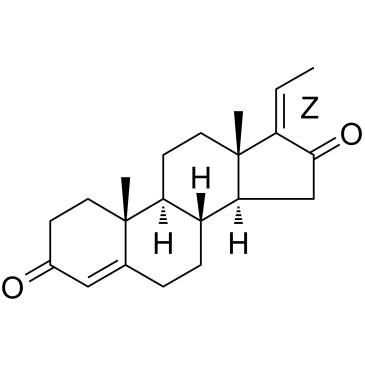固甾酮

固甾酮结构式

|
常用名 | 固甾酮 | 英文名 | Z-Guggulsterone |
|---|---|---|---|---|
| CAS号 | 39025-23-5 | 分子量 | 312.446 | |
| 密度 | 1.1±0.1 g/cm3 | 沸点 | 463.3±45.0 °C at 760 mmHg | |
| 分子式 | C21H28O2 | 熔点 | 188-190° | |
| MSDS | 中文版 美版 | 闪点 | 172.3±25.7 °C | |
| 符号 |

GHS07 |
信号词 | Warning |
|
Chemical genetics reveals a complex functional ground state of neural stem cells.
Nat. Chem. Biol. 3(5) , 268-273, (2007) The identification of self-renewing and multipotent neural stem cells (NSCs) in the mammalian brain holds promise for the treatment of neurological diseases and has yielded new insight into brain cancer. However, the complete repertoire of signaling pathways ... |
|
|
Genetic mapping of targets mediating differential chemical phenotypes in Plasmodium falciparum.
Nat. Chem. Biol. 5 , 765-71, (2009) Studies of gene function and molecular mechanisms in Plasmodium falciparum are hampered by difficulties in characterizing and measuring phenotypic differences between individual parasites. We screened seven parasite lines for differences in responses to 1,279... |
|
|
Conformational dynamics of human FXR-LBD ligand interactions studied by hydrogen/deuterium exchange mass spectrometry: insights into the antagonism of the hypolipidemic agent Z-guggulsterone.
Biochim. Biophys. Acta 1844(9) , 1684-93, (2014) Farnesoid X receptor (FXR) is a member of the nuclear receptor superfamily of transcription factors that plays a key role in the regulation of bile acids, lipid and glucose metabolisms. The regulative function of FXR is governed by conformational changes of t... |
|
|
Effect of guggulsterone and cembranoids of Commiphora mukul on pancreatic phospholipase A(2): role in hypocholesterolemia.
J. Nat. Prod. 72 , 24-8, (2009) Guggulsterone (7) and cembranoids (8-12) from Commiphora mukul stem bark resin guggul were shown to be specific modulators of two independent sites that are also modulated by bile salts (1-6) to control cholesterol absorption and catabolism. Guggulsterone (7)... |
|
|
Design, synthesis, and evaluation of non-steroidal farnesoid X receptor (FXR) antagonist.
Bioorg. Med. Chem. 15 , 2587-600, (2007) A series of substituted-isoxazole derivatives was prepared as candidate farnesoid X receptor (FXR) antagonists, based on our previously proposed ligand superfamily concept. Structure-activity relationship studies indicated that the shape and the structural bu... |
|
|
Reversion of P-glycoprotein-mediated multidrug resistance by guggulsterone in multidrug-resistant human cancer cell lines.
Eur. J. Pharmacol. 694(1-3) , 39-44, (2012) Multidrug resistance (MDR) presents a serious problem in cancer chemotherapy. Our previous studies have shown that guggulsterone could reverse MDR through inhibiting the function and expression of P-glycoprotein (P-gp). The present study is to further investi... |
|
|
Src-mediated cross-talk between farnesoid X and epidermal growth factor receptors inhibits human intestinal cell proliferation and tumorigenesis.
PLoS ONE 7(10) , e48461, (2012) Besides its essential role in controlling bile acid and lipid metabolism, the farnesoid X receptor (FXR) protects against intestinal tumorigenesis by promoting apoptosis and inhibiting cell proliferation. However, the mechanisms underlying these anti-prolifer... |
|
|
Enhanced antitumor effect of combination therapy with gemcitabine and guggulsterone in pancreatic cancer.
Pancreas 41(7) , 1048-57, (2012) Guggulsterone is a dietary plant sterone possessing therapeutic potential against cancers. However, the antitumor effect of this natural compound on pancreatic cancer has not been determined yet. This study was designed to investigate the therapeutic efficacy... |
|
|
Hypolipidemic agent Z-guggulsterone: metabolism interplays with induction of carboxylesterase and bile salt export pump.
J. Lipid Res. 53(3) , 529-39, (2012) Z-Guggulsterone is a major ingredient in the Indian traditional hypolipidemic remedy guggul. A study in mice has established that its hypolipidemic effect involves the farnesoid X receptor (FXR), presumably by acting as an antagonist of this receptor. It is g... |
|
|
Farnesoid X-activated receptor antagonists from a marine sponge Spongia sp.
Bioorg. Med. Chem. Lett. 16 , 5398-402, (2006) Three novel (1-3) and two known (4-5) scalarane sesterterpenes were isolated from a marine sponge of the genus Spongia. The isolated compounds showed potent inhibition of transactivation for the nuclear hormone receptor, FXR (farnesoid X-activated receptor), ... |